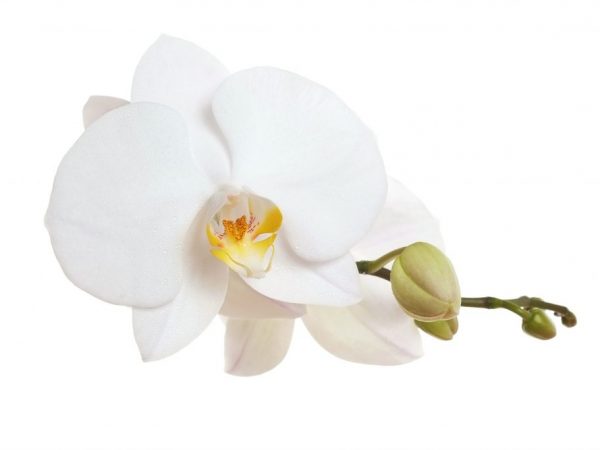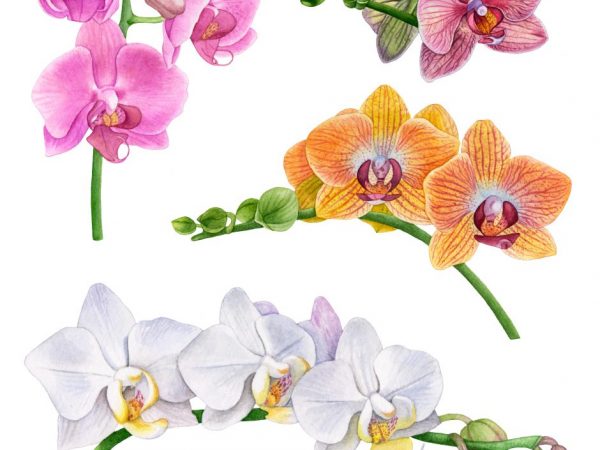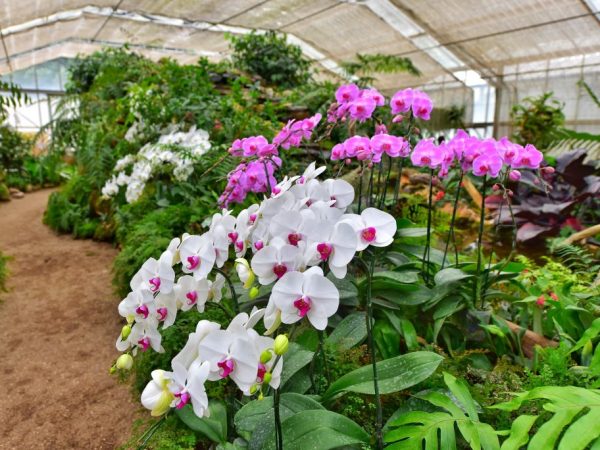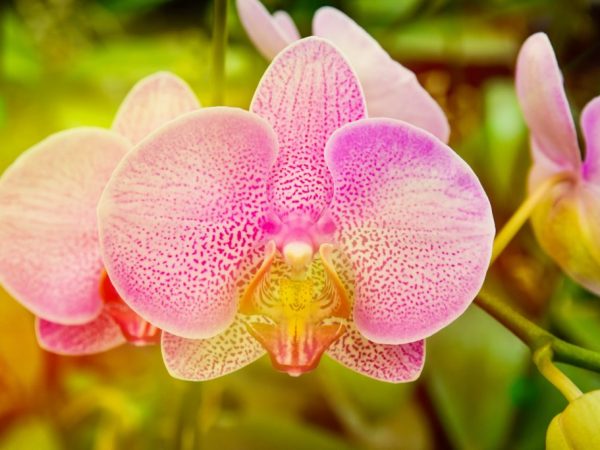Features of the growth of orchids
Many people do not know that the orchid flower is an epiphytic plant. In nature, it grows on trees in humid forests. But some species settle on mountain rocks or on the ground. Florists class them as capricious crops. Representatives of the orchid family are successfully grown at home, but the conditions of detention should be close to natural.

Features of the growth of orchids
How it grows in the wild
The miracle plant grows in different regions. There are 35 thousand species, and hybrid varieties - about 45 thousand. Some species live up to 100 years.
The ideal environment for an orchid is a humid and warm climate, so it is more common in the jungle. Feels good in shade out of direct sunlight. Some species grow only on one island, they are not found anywhere else. For example, the Angrekum variety grows only in Madagascar.
According to the characteristics, the culture is perennial, belongs to the herbaceous types. Most orchids feed on decayed plant debris that accumulate on the bark with the help of aerial roots. The root system takes part in photosynthesis.
Differs in graceful buds of different sizes and colors. The largest orchid flowers have petals 90 cm long (Paphiopedilum sanderianum). There are varieties that reach 20 m in height. The smallest flower in the Platystele jungermannoides orchid is 1 mm in diameter.
The shape of the plants depends on the variety and the method of pollination (insects or hummingbirds). By the type of branching, two groups are distinguished:
- monopodial - the apical growth point is active throughout the life of the shoot;
- sympodial - the shoot grows to a certain length, then dies off or forms an inflorescence.
The structure of a culture has features that help it adapt to different growing conditions. Thickened leaves and shoots serve as a kind of water reservoir.
Interesting Facts
The origin of the name for orchids is associated with the philosopher Theophrastus. As a result of scientific research, he came across an unfamiliar flower with roots in the form of a paired bulb and named it "orchis", which means "egg" in Greek.
In Europe, culture appeared thanks to the English botanist, who in 1731 was sent a dried flower from the Bahamas. He planted it, assuming that life was still preserved in the tubers. After some time, the culture came to life and blossomed.
When blooming, the smell of an orchid is not always felt. Only some of its species emit a pleasant, rich aroma. But there are also varieties whose flowers smell like mold, rotten meat. They are not suitable for home conditions.
There are species that are valued not for the beauty of flowers, but for the decorativeness of the leaves. Botanists do not distinguish them into a separate group. Orchidists do it.The leaf plates of such plants are distinguished by brightly colored veins that look spectacular under the light of a lamp.
Interesting Facts:
- The flowers of the culture do not cause allergic reactions.
- Cut arrows last longer in water than other colors.
- The world's largest collection of the orchid family is collected in the Singapore Orchid National Park - 60 thousand species and 400 varieties.
- Vanilla is the thin, long fruit of the Vanilla Planiflora orchid that looks like a vine.
- The most expensive flower in the world is the Gold Kinabalu orchid, which blooms only after reaching the age of 15. The cost of one escape is about $ 5,000.
- In China, the culture is used to drive out evil spirits, in India - as protection from the bites of poisonous snakes.
- There is a predatory representative of this family. She only eats insects.
Growing at home

Features of the growth of orchids
Since the orchid is recognized as the queen of flowers, many want to have it in their collection. For beginner growers, the easy-to-care phalaenopsis ampelous orchid or bush dendrobium is most suitable for growing.
Choosing a flower
Before buying a plant, it must be examined. Signs of a healthy appearance:
- petals - bright and elastic;
- leaves - bright green, without spots, cobwebs, mold;
- roots - green or light, silvery (depending on soil moisture), fleshy and elastic.
If you are going to be transported home in the cold season, the plant is wrapped in several layers of paper, in frost it is additionally covered with a plastic bag.
Souvenirs from Thailand have become popular now - Thai orchid sprouts are placed in a glass bottle, as well as everything necessary for their life. When returning to their home country, tourists wait for the sprouts to occupy the entire volume of the vessel. Then they break it and plant the culture in a flower pot.
Quarantine
After purchase, the plant needs time to adapt. For the first two weeks, it should stand alone - separate from other indoor plants. At this time, watering is reduced, no fertilizing is performed, and direct sunlight is prevented. Then, little by little, the moistening of the substrate is renewed, the flower is accustomed to the sun.
Optimal conditions
The conditions in which an orchid is kept affect its appearance and health.
Illumination
The place is determined according to the type of plant, which are shade-loving and photophilous.
When placed on a windowsill, it is better to choose an east or west window. It has good lighting in the cold season, and in summer it does not get direct sunlight. This will prevent sunburn. When the plant blooms, sometimes it is removed to the back of the room. But after the end of the flowering period, they return to their original place.
Houses install racks or shelves near the south-west or south-east window at a distance of no more than 1 m. If the pot is placed on the south window, then in the summer it is shaded.

Any orchid needs light
When placing a plant on the northern window, it is supplemented with phytolamps in the autumn-winter period. One of the main requirements is 12-hour daylight hours. The distance between the lamp and the flower should be at least 20-30 cm.
Illumination is corrected by examining the leaves. With a lack of light, they darken, with an excess, they turn yellow, become covered with brown and dry spots. If there is a need to rearrange the flower pot, then the position towards the light should be the same. It is undesirable to move the culture during the period of peduncle formation.
Temperature regime
Growing an orchid at home, take into account all its preferences. These include the optimum temperature. Crop varieties are divided into the following groups:
- thermophilic;
- those that prefer medium temperatures;
- cold-loving.
Accordingly, plants need indicators from 12 to 25 ° C. In most cases, orchids bloom if the night and day temperatures differ by 3-5 ° C.You should also regularly ventilate the room, but the flower should not fall under the draft. If it's freezing outside, the pot is removed from the window when it is opened.
Often, decorative Florariums of a special design are created for cultivation, which have a ventilation and heating system. Thanks to them, they withstand one temperature during the day, and another at night. The florarium is also created in a glass, in an aquarium.
Air humidity
It is better to keep an orchid at rates of 60-80%. If the air in the apartment is too dry, it is worth spraying the orchid and wiping the leaves with a wet sponge. To increase humidity, keep a flower pot near the aquarium. An indoor fountain or humidifier is also used.
Care
In order for the orchid plant to please with a healthy look and good flowering, it is worth taking proper care of it.
Watering
The substrate is moistened when the pot becomes very light. The need for water is evidenced by the lack of moisture on the walls of the transparent pot, as well as the clarification of the roots. Water the culture in several ways:
- sprinkling: the plant is watered in the shower until the substrate gets wet;
- immersing the pot in a bowl of water for 15-20 minutes;
- from a watering can: with this watering, make sure that the substrate is moistened evenly.
Moisten the substrate in the morning or afternoon, so that the plant dries out in the evening. Watering is increased during active growth and in the heat, reduced - during dormancy. After completing the procedure, allow excess moisture to drain. Water is removed from the growth point with a napkin. A disturbed watering regime threatens the development of various diseases.
Top dressing
The maintenance of the culture provides for the introduction of nutrients. They are used when shoots, peduncles, leaves are actively growing, but not during dormancy. Thanks to fertilizers, orchids bloom and develop well.
They are fed with complex preparations marked "for orchids". Funds are added to a pre-moistened substrate 2 times a month. Their dosage is strictly monitored, since an excess of substances reduces the immunity of the culture.
Flowering stimulation
If the orchid does not give flowers for a long time, it is worth stimulating this process. To this end, the culture succumbs to a stressful situation. If you take it out to a cooler place or reduce watering, then the plant will release a new peduncle.
Transfer

Transplant the plant with tightness in a pot
Manipulation is performed every 2-3 years. An urgent transplant is needed for the following indications:
- the root system has sprouted through holes, strongly branches or rots;
- pests are found in the substrate or it has decomposed.
You need to start the transplant with the preparation of the soil. In the store you can buy a ready-made mixture, which includes bark sawdust, sphagnum moss, peat. But in such a soil there is a risk of water stagnation. Better to plant in pine bark.
The transplant container is taken a little larger. Large orchids are planted in pots, smaller ones in blocks. Holes are made in the bottom of the vessel, drainage is laid at 1/3 of the height.
Recently, the crown pot has gained popularity. Its advantages are free access of oxygen to the roots and good ventilation. Minus - dust is poured through the cracks into the stand. It doesn't look aesthetically pleasing. Also, when watering, it is difficult to remove excess moisture from the pallet, since it is attached to the sticks.
rules
The transplant is performed step by step:
- remove the flower from the pot;
- separate the roots from the substrate;
- remove dry and rotten areas with scissors treated with alcohol;
- places of cuts are sprinkled with brilliant green, activated carbon;
- the plant is placed in a pot, slightly scrolled;
- fall asleep with a substrate.
Contraindications to the procedure are blooming orchids. Some species require a garter to keep the crop upright. For this purpose, take a bamboo stick. To prevent the arrow from breaking, they also use a special holder, which is sold in flower shops.
Pruning
Features of the process are to trim the arrow with a garden pruner. It is not produced immediately after the end of the flowering period. It is worth waiting until the peduncle dries up. If it is still green, the culture can please again with flowers. All actions are performed with extreme care so as not to damage the leaves and shoots. The shoots after removal should be 2.5-3 cm long. The wounds must be treated. The inventory is also disinfected.
If you need to rejuvenate the orchid, then you should perform the following manipulations:
- remove excess leaves;
- clear the root system;
- update the substrate.
Reproduction

Reproduction by dividing the roots
Breeding is done in one of the following ways:
- dividing large plants (each part should have 2-3 bulbs and healthy roots);
- side shoots (when the roots grow, the shoots are cut off);
- apical cuttings (cut off the top so that several live juicy aerial roots remain on it);
- pseudobulbs;
- children (when the orchid has children, they wait for the formation of several leaves and roots, and then plant them. To speed up the process, they build a greenhouse);
- seeds (it is difficult to dilute with this method at home).
Pests and diseases
Often the culture begins to hurt, and the flowering of the orchid is threatened:
- fungal: brown, gray, root, fusarium rot, anthracnose, powdery mildew, mold;
- bacterial: bacterial spotting;
- viral: mosaic spotting (in rare cases).
Fungal diseases are treated with one of the following fungicides: Fitosporin-M, Skor, Oksikhom, Radomil Gold, Topaz. If the orchid is flooded, dry the substrate. Against bacterial - use bactericides or antibiotics, cut out the affected areas. Culture dies from viral diseases, there is no way to save it.
Different insects can also harm:
- aphid;
- whitefly;
- shield;
- mealybug, etc.
If pests are identified, insecticides or such a folk remedy are used against them: 150 g of crushed soap, 5 g of copper sulfate, 1 liter of water.
Care errors
Most of the problems are manifested due to care:
- Improper watering - if the flower is poured, the root system gets wet, darkens and begins to rot, edema forms, specks of a brown tint appear on the flowers. If you don't take action, culture dies. When there is a lack of water, the leaves wrinkle, wither, and dry out over time.
- Improper illumination - with a lack of light, the leaves do not reach a large size, buds do not form. Burns can occur from direct sunlight. They also happen when the distance between the phytolamp and the flower is not observed.
- Wrong temperature regime - if you place an orchid on an unheated balcony in cold weather, it will overcool. Then dark spots appear on the leaves, their edges crack.
- Incorrect dosage of fertilizers - from an excess of feeding substances, the roots stop growing, the leaves become lethargic, peduncles do not form. When the color of the leaves lightens, the plant lacks nitrogen.
- Suboptimal humidity - at low moisture levels, the leaves lose their turgor, droop, buds and flowers dry out.
These problems can be prevented by keeping the crop in an environment with an appropriate microclimate.
Decorative color assignment
In addition to indoor varieties of culture, there are also street varieties. They are rarely planted. They are found even in Moscow parks, but these species look more modest than their tropical relatives. In most cases, these are orchids called "Slipper".
To preserve the vivid beauty of flowers, it is necessary to dry the fallen or slightly wilted inflorescences. Artificial plants of different colors are used in interior decor. The branches look especially beautiful in a floor vase. The beige color of flowers is perfect for complementing the interior of rehabilitation centers, holiday homes, as this shade personifies calmness and tranquility.
The flowers of the culture are so refined that even pastry chefs use their appearance to decorate cakes and cupcakes. For this, there are special silicone weiners, with the help of which artificial flower petals are created. A cosmetic fragrance is also made, which has an orchid aroma. The substance is used to make soap.
Conclusion
The orchid is also called the queen of flowers. Its multi-colored petals will delight the eyes of the most whimsical aesthetes, decorate every botanical garden or house. According to the description, the culture is capricious. But observing the rules of care, it is easy to achieve the desired result.


